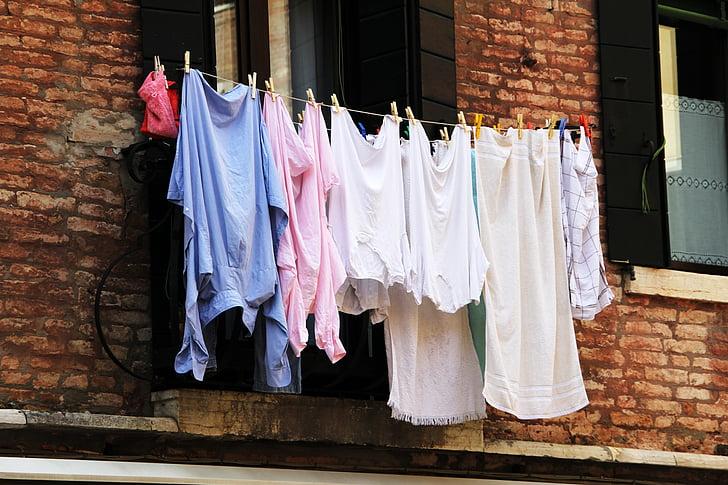Editor's Note: Tiffany Sprague is NRRI's Sustainability Coordinator, helping us all live out our best sustainable lives, both at work and at home. This is her monthly blog series.
With cozy autumn and holiday season upon us, many of us may find we are spending more time in our laundry room (or creepy, drafty basements, wearing knee-length winter coats and gloves, fingers freezing as towels are fluffed…[Tiff, circa 2012, grad school duplex rental]). College students visiting home over breaks, family members spending evenings...weeks...too much time really, inhabiting guest bedrooms and basement couches -- all that clothing and bedding sure does add up.
And, because I expect many folks are using handkerchiefs, reusable napkins, and cleaning cloths instead of paper towels and other throwaways (ehm I right?) -- laundry baskets may be bursting at the seams. So this month we are going to discuss various ways to create an eco-friendly laundry experience.
Energy Star Products

I think the first thing that comes to mind is owning an Energy Star certified washer and/or dryer. Each year, Energy Star puts out a list of the most efficient appliances for the year, and the 2021washer list and dryer list have a lot of snazzy options. But, not all of us can afford to upgrade our washer and dryers every few years (which leads to an entirely different issue of material waste and end of life recycling, so for now, let's assume everyone has a crusty old washer and dryer like I do).
Wonder how a product becomes Energy Star Certified, and if it is a real thing? Well, the Environmental Protection Agency makes the call on what gets Energy Star Certified, and the EPA is a group of real scientists, so, yes, it is very real. You can also read more on the specifications required for certification, or watch a cute little video about it.
Things You Can do to Improve Efficiency
Not everything needs to be fancy, newly purchased or complicated. Some classic rules to live by:
- Wash and dry full loads.
- Use cold water (reduces additional energy consumption to heat up your hot water tank).
- Don't over dry. Better yet, use a clothesline. (My favorite. Makes me feel European and sophisticated. Other days, very Laura Ingalls and rugged homesteader. Either way, smug. Definitely smug. And is there any better way to do laundry than smugly hanging clothes on a line? Correct. There is not.)
- Regularly clean lint screens -- fire safety and efficiency -- a double-win!
- Dry in consecutive loads while the dryer is still warm to reduce the energy needed to raise dryer temperature. (That is, when you aren’t smugly hanging your clothes.)
Microfiber Pollution
Microfibers. Microplastics. All the rage right now in the media and scientific research. And, truthfully, the outlook isn’t too good. Essentially, the fibers from that PolarTec fleece jacket shed off in your washer; these fibers are not natural, and are made, in essence, from plastic. From your washer, they pass through wastewater treatment plants, and end up in our lakes and streams. Little animals eat them, big animals eat the little animals, then bam, bald eagles are extinct.
While you can act like Steve Jobs and freeze your clothing rather than wash them (Smithsonian Magazine has an article on freezing jeans [essentially, meh]). They also make products which can capture these microfibers from your wash load.
Dryer Sheets Wool Dryer Balls
Are you still using dryer sheets? Well, that is so 1990s. The new rage is wool dryer balls. They don't contain chemicals (I mean, have you ever asked yourself what is on a dryer sheet?), they help to floof up your clothing, and you can place essential oils on them if you'd like to lightly scent your clothing.
There are a bunch of different brands out there, and small crafters who sell them at local shops and on Etsy. They last forever; I owned a set for about 10 years before I had to replace them (they unraveled; the surviving ones are cat toys). I like 6 balls in use at once to really give those towels a nice floofing.
Dryer Safety & Efficiency
Have you ever really cleaned out your dryer? I mean, like really gotten in there? Well, you should. It can maintain the efficiency of your dryer and minimize safety concerns like lint fires.
Ace Hardware has a fantastic video (3 minutes) on how to clean out your dryer and replace your vent line.
While laundry may not be the most exciting adulting activity, I appreciate the technological advancements and ingenuity that allows for a laundry day experience with minimized impact on the environment. I hope you will take a moment next time you are scrubbing chocolate stains out of your favorite sweater to reflect on your gratitudes for this awesome planet and the many wonders Mother Nature offers.
Until next month - with gratitude and in reflection,
Tiff
